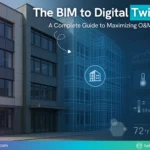Above & Beyond 3D BIM
November 17, 2022

The gradual rise and continuous adoption of Building Information Modelling (BIM) technology have something helpful to offer to each stakeholder—investor, owner/developer, contractor, architect, construction materials supplier, technology supplier, equipment supplier, or customer—involved in the execution of an end-to-end project. BIM, the digital representation of a building and having characteristics of real-world building elements, is indeed the present and future of the projects in the Architecture, Engineering, Construction, and Operations (AECO) industry. Its utility does not end at making the designing and construction more straightforward, processes seamless and revolutionizing these industries by offering facilities that go a step beyond what is expected.
Are you caught in the ‘how’ and ‘where’ of the reach of BIM technology?
Don’t worry; we’ll answer your queries by taking you through some of the things BIM does beyond the basics. Although there are several dimensions that BIM has been categorized into as per the various purposes it intends to fulfill, we’ll explore five ways in which the scope of BIM is seen to be going above and beyond the 3D?
1. Digital Twin: Defined as “a virtual model designed to reflect a physical object accurately,” is best suited for large-scale processes in manufacturing, aircraft production, jet turbines, building construction, engineering industries, etc. This super technology is accessible by a virtual reality (VR) headset and is stored in the cloud. Digital twins help improve efficiency within complex machinery and big engines and they ease the process in mechanisms of generating and transmitting power. In addition to these, Digital Twins can be used to create virtual models of products that can predict the performance of the object. For example, Digital Twins can stimulate the object’s behavior in the case of a smart lock at the door. Hence, it aids the management of projects too.
2. Facility management: We’ve now entered the years of smarter buildings and the smartest technology. 7D BIM, when used for facility management, allows maximum utilization of BIM via storing and retrieving project information and documentation. The as-built model information about the maintenance, programming, operation schedule, technical and warranty details, etc., can be stored and extracted to optimize facilities management. It helps facility managers communicate requirements and expectations with the stakeholders and teams working on the projects. It is central to asset management and enhancing current systems in the construction industry.
3. BIM for Health and Safety management: This method will recognize the real state of construction activities from as-built video data based on as-planned BIM data using computer vision algorithms. Currently, computer vision is used extensively in various domains of the construction industry, such as “hazardous area identification for safety management, concrete crack detection for quality management.” BIM fulfills the practical requirements of on-site construction management. “The three areas where BIM can influence Health and Safety (H&S) management are: evaluation of site conditions for workers; identification of potential safety hazards; and analysis, planning and validation of safety measures,”?mentions WIT Press.
4. BOQ and BOM for cashflow analysis and project financing: With the 5D model, companies have the service of real-time cost visualizations and adjusting the costs on the go, along with the option of receiving information about the automatic count for components/system/equipment concerning a project. With 5D BIM, detailed information about Bills of Quantities (BOQ) and Bills of Materials (BOM) is offered to the project managers to understand the inventory requirements associated with a project, making it easier for the cost estimators in the AEC industry to keep track of the budget on any project.?
5. Sustainability and Energy Analysis Model: Upping the game in this era to balance nature’s resources and humans’ deeds is crucial for any sector. However, this concept becomes challenging for the construction industry to adopt as there’s a direct correlation between energy requirements and development. However, with the translation of BIM into the Energy Analysis Model (EAM), engineers could create energy and environmental performance. An (EAM), as described by many, “is essentially an abstraction of a building’s overall form and layout into a ‘computational network’ that can capture all of the key paths and processes of heat transfer throughout the building effectively.” Using this model, the effects of greenhouse emissions could be reduced and steer the industry toward sustainable functioning.?
Although the points mentioned above are only a few use cases of BIM, several others benefit other industries. It’s only about time that we see the technological revolution that comes from several dimensions of BIM. By now, you would have been able to map the extent of BIM technology beyond that planning and designing stage.?
Stay tuned for our next blog!















